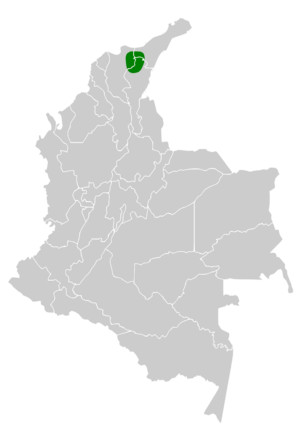Streak-capped spinetail facts for kids
Quick facts for kids Streak-capped spinetail |
|
|---|---|
 |
|
| Conservation status | |
| Scientific classification | |
| Genus: |
Cranioleuca
|
| Species: |
hellmayri
|
 |
|
The streak-capped spinetail (Cranioleuca hellmayri) is a small bird that belongs to the ovenbird family. It gets its name from the streaky pattern on its head and its pointy tail feathers. This bird is found mainly in the mountains of northern Colombia and a small part of Venezuela. It lives in forests and spends its time looking for food among the trees.
Contents
What Does It Look Like?
The streak-capped spinetail is a small bird, about 14 to 15 centimeters (5.5 to 5.9 inches) long. It weighs around 14 to 16 grams (0.49 to 0.56 ounces). Both male and female birds look very similar.
This bird has a dark brownish and buff face with a thin whitish stripe above its eye, like an eyebrow. Its head is a reddish-chestnut color with dark streaks. Its back is brown, becoming lighter near its tail. The feathers covering the base of its tail are a reddish-brown color.
Its wings are mostly reddish-chestnut. The tips of its flight feathers are a darker brownish-gray. The tail is also reddish-chestnut and has pointed tips, with feathers that get shorter towards the sides.
The chin and throat of the streak-capped spinetail are whitish. Its chest and belly are a pale brownish-gray or grayish-olive. The sides of its body and the feathers under its tail are a slightly deeper brown. Its eyes are pale yellow to whitish. The upper part of its beak is dark, while the lower part is pinkish. Its legs and feet are yellowish-green to pinkish.
Where Does It Live?
The streak-capped spinetail lives almost entirely in a special mountain area called the Sierra Nevada de Santa Marta in northern Colombia. This mountain range is isolated, meaning it stands alone.
One bird was also found in the Venezuelan part of the Serranía del Perijá mountains. This bird prefers to live in mountain evergreen forests. It can be found in both old, untouched forests (primary forests) and forests that have grown back after being disturbed (secondary forests).
In Colombia, these birds live at elevations between 1,200 and 3,000 meters (about 3,900 to 9,800 feet) above sea level. The bird found in Venezuela was at a lower elevation of about 700 meters (2,300 feet).
How Does It Behave?
Moving Around
In Colombia, the streak-capped spinetail stays in the same area all year round. It does not migrate. We don't know much about if or how these birds move around in Venezuela.
What It Eats
The streak-capped spinetail mainly eats arthropods, which are small creatures like insects and spiders. It usually forages in pairs, meaning two birds look for food together. Often, they join a mixed-species feeding flock. This is a group of different bird species that feed together.
The birds usually search for food in the middle and upper parts of the forest trees. Sometimes, they will look lower down. They are very agile and can climb along small branches. They find their prey by picking it off tree bark, plants that grow on other plants (called epiphytes), and other bits of debris.
Reproduction and Life Cycle
Scientists are still learning about the breeding season of the streak-capped spinetail. However, eggs have been seen between September and November. It is believed that these birds are monogamous, meaning they mate with only one partner during the breeding season.
Their nest is shaped like a ball and is made of grass and leaves. They hang this nest from a tree branch. Not much else is known about how they raise their young.
What Sounds It Makes
The full range of sounds made by the streak-capped spinetail is not completely known. What is thought to be its song or call is described as a weak, high-pitched, squeaky trill. It sounds like "ti, ti, t, t-t-t-t" and can also be a "shrill, squeaky trill, accelerating."
Conservation Status
The International Union for Conservation of Nature (IUCN) is an organization that checks on the health of animal populations. They have assessed the streak-capped spinetail as a species of "Least Concern." This means it is not currently considered to be in danger of disappearing.
However, this bird lives in a limited area. Its total population size is not known, but it is thought to be decreasing. No immediate threats to the species have been found. It is considered common in its small range in Colombia. Its status in Venezuela is not known.


